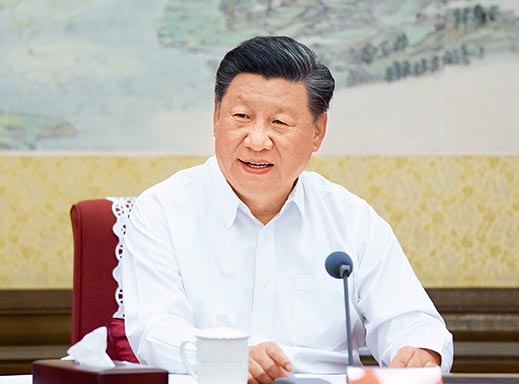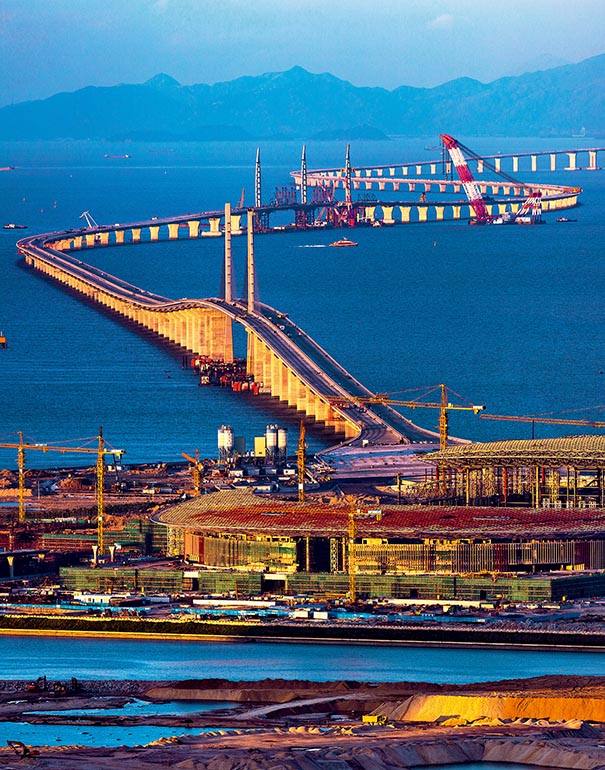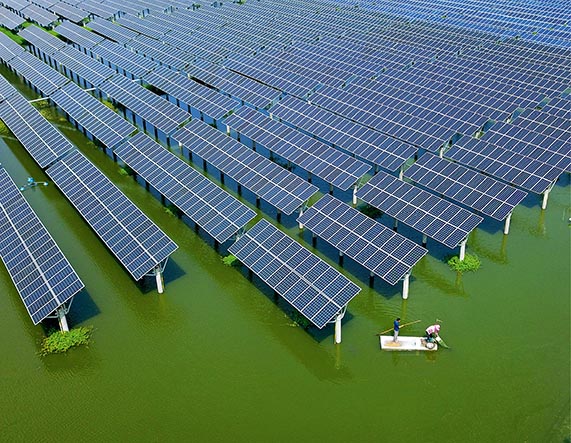
Aerial view of Nanjing South High-speed Railway Station in the provincial capital of east China’s Jiangsu Province. (VCG)
China and the world are now undergoing profound changes unseen in a century. How should China cope with the challenges and transform them into new opportunities for development?
At this critical juncture, the fifth plenary session of the 19th CPC Central Committee deliberated and adopted the Proposals of the CPC Central Committee for Formulating the 14th Five-Year Plan for National Economic and Social Development and the Long-Range Objectives Through the Year 2035, agreeing on a new blueprint for China’s development over the next 5 to 15 years, with a vision for the next hundred years.
Based on the 14th Five-Year Plan, the CPC Central Committee proposed long-range goals for 2035 to achieve basic modernization within 15 years. The CPC is gearing up to deliver its first centenary goal in 2021, while ready to lead the Chinese people on a new journey towards the second centenary goal. New concepts and new strategies will guide China’s development in the new era.
ALL EYES ON THE 14TH FIVE-YEAR PLAN
Many observers are following formulation of the blueprint for China’s future development at a historic juncture
On October 26-29, 2020, the fifth plenary session of the 19th Communist Party of China (CPC) Central Committee convened in Beijing. The plenum conducted in-depth analyses of the international and domestic situation and adopted the proposals for formulating the 14th Five-Year Plan (2021-2025) for Economic and Social Development and the Long-Range Goals for 2035. Over the last five years of the 13th Five-Year Plan, China has made remarkable achievements in all aspects of economic and social development.
Compared to previous five-year plans, the 14th Five-Year Plan is distinctive in terms of formulation, timing, modality, content, and other areas, and has attracted intense scrutiny across China and around the world.
Unique Power of China’s Five-Year Plans
On October 22, the Standing Committee of the Political Bureau of the CPC Central Committee organized a meeting to review the implementation of the 13th Five-Year Plan and make recommendations for the formulation of the 14th Five-Year Plan.
Economic globalization is now facing headwinds, and the world is undergoing profound changes unseen in a century pushing it into a period of turbulence and transformation. China is poised at a critical stage of realizing the great rejuvenation of the nation. The change in the principal contradiction in Chinese society creates new demands and requirements for high-quality development. Formulation and implementation of five-year plans is an important method for the Party to govern the country and a key “code” for the governance of China.
“Preparedness ensures success while neglect spells failure,” goes an old saying. China’s Five-Year Plans show distinctive Chinese features. The first was issued in 1953. Ten such plans were formulated before 2005, interrupted only once by economic adjustment from 1963 to 1965. Plans since the 11th Five-Year Plan (2006-2010) have been referred to as “guidelines.” These unique guidelines combine long-term planning with annual goals, detailed national economic development strategy for all departments and localities, and national policy harmonized with local development, creating a strong forward-looking, leading and binding force.
Five-Year Plans have served as the weathervane of China’s development. Formulation of each plan generally begins during the middle of the previous plan period. The process, complicated by necessary involvement from many government departments and research institutions, generally lasts two to three years. A drafting group is responsible for researching subjects, formulating a framework, drafting an outline, drawing up special guidelines, and soliciting opinions from different sectors before presenting a draft document to the National People’s Congress for deliberation and approval. China’s Five-Year Plan captures not only the vision and expectations for the country’s future, but also creates requirements and constraints for the ruling party itself, which ensures a strong backing and binding force to promote smooth implementation. Five-Year Plans form a complete closed loop that keeps moving forward from formulation to implementation, supervision, evaluation, and so on.
Combining Top-Level Design with the People’s Wisdom
The drafting group usually carries out research and solicits opinions from different sectors of society before drafting the outline.
According to a decision from the Political Bureau of the CPC Central Committee, the fifth plenary session of the 19th CPC Central Committee would deliberate on proposals for the 14th Five-Year Plan. A drafting group headed by Xi Jinping was established, with Political Bureau Standing Committee members Li Keqiang, Wang Huning, and Han Zheng serving as deputy heads and leading officials of relevant departments and local authorities joining the group. Under the leadership of the standing committee, the drafting group would be responsible for formulation of draft recommendations. On March 30, 2020, the CPC Central Committee issued a notice soliciting opinions on the CPC proposals for the 14th Five-Year Plan to be deliberated at the fifth plenary session within a certain scope of the Party and society.
Formulation of the 14th Five-Year Plan truly embodies the people-centered philosophy of mobilizing the masses to participate in the process of achieving their own goals and spreading their own values. General Secretary Xi Jinping presented a series of explicit requirements for formulation of the 14th Five-Year Plan, emphasizing that solid top-level design requires wisdom from the people. He encouraged people from different sectors of society to contribute to the 14th Five-Year Plan in a variety of ways.
From late July to late September 2020, Xi chaired a series of symposia with entrepreneurs, scientists, grassroots workers, and experts in economic and social affairs, education, culture, sports and other sectors to hear their views and suggestions for formulation of the 14th Five-Year Plan first-hand. As with formulation of previous plans, the Party attached great importance to the wisdom of experts during the entire process. A stark contrast from previous plans has been the involvement of many enterprises including well-known private internet and real estate companies. As more and more enterprises have driven emergence of new sectors, voices from the cutting edge of technological innovation and emerging businesses have become necessary to provide forward-looking and practical assessments of the situation for formulation of a new Five-Year Plan.
For the first time in history, consultation activities for formulation of the 14th Five-Year Plan started online from August 16 to 29. The Party utilized the internet to solicit opinions and suggestions from all of society. The masses participated enthusiastically. Of more than a million comments posted, more than 1,000 valuable suggestions were forwarded to high-level officials. People.cn (People’s Daily Online) launched “Message Board for Leaders” to solicit opinions and suggestions from readers for local-specific information to help formulate the 14th Five-Year Plan, which produced a large volume of fresh cases and valuable strategies for the plan.
According to a decision by the Political Bureau of the CPC Central Committee, the draft proposals would be circulated within a certain scope of the Party, including some retired senior officials, for comments and suggestions. It was also circulated for feedback from the central committees of non-CPC parties, leaders of the All-China Federation of Industry and Commerce, and representatives of non-Party personages.
The drafting group analyzed all the incoming opinions and suggestions one by one and included as many as possible through 366 amendments to the proposals with addition, rewriting, or simplification of 546 opinions and suggestions. This is how intra-Party democracy and socialist democracy work in China.
Driving High-Quality Development
Different historical stages demand different development priorities.
The 14th Five-Year Plan was formulated at the juncture of the COVID-19 pandemic accelerating global changes unseen in a century. The plan had to be oriented towards a longer-term future rather than just short-term pandemic response or even work only over the next five years. The next five years will be an important period for China to achieve progress on the long-range goals for 2035, so the 14th Five-Year Plan is a key link between historic stages.
In preparation for the recommendations, some departments and local governments suggested that a clear growth target be set for China’s GDP or per capita income to double by 2035. After careful study and calculation, the drafting group determined that from the perspective of economic development capacity and conditions, potential for the economy to maintain long-term steady growth is clear. It is entirely possible to reach the current standards of high-income countries by the end of the 14th Five-Year Plan and double China’s GDP or per capita income by 2035. At the same time, the group recognized that in the near future, many uncertain factors from the external environment could exert a negative impact on China’s domestic economic development. The COVID-19 pandemic could end up leaving a far-reaching impact on the sluggish world economy. Therefore, they made the goals of the new medium and long-term plan more focused on optimization of economic structure and improvement of quality and efficiency of development.
Common prosperity is an essential requirement of socialism and the common expectation of the people. Since the 18th CPC National Congress, China has made poverty alleviation the top priority and lifted all rural residents above the current poverty line, a major advancement in promoting common prosperity for all. Prominent problems such as unbalanced and inadequate development and significant disparities in development and income distribution between rural and urban areas and between different regions persist in China. Promoting common prosperity is a long-term task. The draft recommendations suggested that the long-term goal of socialist modernization could be achieved by 2035 “with more tangible progress towards prosperity for all the people.” The document also presented some important requirements and major initiatives including “making solid progress on common prosperity” in reference to improving living standards and quality. Such a statement is unprecedented in communiques from plenary sessions of CPC Central Committees, evidencing its importance moving forward and pointing to the end goal of development. The attitude of seeking truth from facts conforms to the law of development, which will be beneficial for future work.
As China endeavors to achieve its two centenary goals, the 14th Five-Year Plan will lay a solid foundation for long-term, high-quality, and dynamic development.

Chinese President Xi Jinping delivers an important speech at a symposium with experts in economic and social fields in Beijing on August 24, 2020. (LI XUEREN)

The fifth plenary session of the 19th CPC Central Committee was held in Beijing from October 26 to 29, 2020. (YIN BOGU)
THE POWER OF FIVE-YEAR PLANS
The Five-Year Plan practice captures the strength of China’s governance
By Zhan Chengfu, Vice Minister of Civil Affairs

The last steel tower of the Hong Kong-Zhuhai-Macao Bridge is installed on June 2, 2016, enabling the final connection. (CHEN XIANYAO)
Chinese President Xi Jinping, also general secretary of the Communist Party of China (CPC) Central Committee, has stressed that formulating and implementing the Five-Year Plan for National Economic and Social Development is an important method for the CPC to govern the country. Since its founding in 1949, the People’s Republic of China has acted on 13 Five-Year Plans, which have resulted in a consistent stream of miracles that testify to the unique and enormous appeal of the Chinese system and governance.
Highlighting the CPC’s Extraordinary State Governance Capability
The Five-Year Plan sets goals and policies for national development over a certain period of time. Integrating a functioning market and an effective government is of immense significance for national development in terms of facilitating realization of development goals, remedying market failures, efficiently allocating public resources, and advancing comprehensive, coordinated, and sustainable development. General Secretary Xi said, “Good planning produces the greatest benefits, whereas poor planning results in the worst waste, and flip-flopping is the first no-no of planning.” Crafting a solid Five-Year Plan and sticking to it has been tremendously important for China’s development. Considering the remarkable economic and social progress that China has made, the merit of well-crafted and effectively implemented planning cannot be overstated.
How is the CPC able to make these plans that correctly assess development and effectively steer the ship of the nation through unforeseen waves? Because a science-based system is used to formulate them. In this system, the CPC’s various proposals for the Five-Year Plan for National Economic and Social Development are crucially important as they are forward-looking, strategic and guiding in nature.
The CPC is the ruling party and the leadership core of the cause of building socialism with Chinese characteristics. It has the power and responsibility to make proposals for formulating the Five-Year Plan. Seeking to promote democracy and build as broad a consensus as possible, the CPC makes precise analysis and prognosis of the internal and external environment affecting China’s economic and social development and accordingly plans a path, major goals, priority areas, and key tasks of national development for the coming five years.
When drafting proposals for the Five-Year Plan, the Standing Committee of the Political Bureau of the CPC Central Committee holds regular meetings to study the issues. After the final draft takes a rough shape, the Political Bureau brings it to the plenary session of the CPC Central Committee for deliberation and approval, during which time more solid opinions are added to the text. Only after the draft is passed at the plenum do the collective proposals that constitute the Five-Year Plan for National Economic and Social Development become a cohesive document that guides central and local governments in making development plans. In accordance with the various proposals, the State Council organizes the formulation of the next Five-Year Plan. After discussion and approval at the executive and plenary meetings of the State Council, the plan is reviewed by the National People’s Congress, where propositions of the CPC and the government are adopted as the will of the nation.
The CPC makes plans for the strategic development of China, and more importantly, sees that they are fully implemented. From its 1st to 19th National Congress, the Party set goals for specific stages in a rational and holistic way and worked diligently to ensure they materialize. The Five-Year Plans, from the 1st to the 13th, have been expressions of the propositions of the Party and the will of the people. No other political party or government in the world has been able to chart specific goals stage by stage for national development and rally more than 1 billion people to work toward the goals. This will make China stand out in greater world modernization.
Logging China’s Development and Journey to the Chinese Dream
The CPC is known for its ability to integrate staged goals with lofty ideals and make strenuous efforts in phases to realize them. Drawing and implementing the Five-Year Plan is an important approach to doing so. With firm focus on socialist modernization, the plan charts a course of action to eventually make a grand blueprint reality.
Since the commencement of reform and opening up, China has devised eight Five-Year Plans, which have laid the foundation for China to realize national rejuvenation. In recent years, the CPC presented “two-step,” “three-step,” and “new three-step” strategies and called for securing success for socialism with Chinese characteristics for a new era at its 19th National Congress. Compared to these long-term arrangements, the Five-Year Plans are designed for a certain period of time, representing milestones for China’s progress in socialist modernization and marking its progress in realizing the Chinese Dream.
Decoding China’s Success
Some foreign scholars have lamented that as China is planning for the next generation, Western countries are planning for the next election. How are the CPC and the Chinese government able to maintain such dedication to a single blueprint, stage by stage, generation after generation? The answer involves multiple factors, but two stand out in particular.
The first is the advanced nature of the CPC. As the vanguard of the working class, the people, and the nation of China, the CPC strives to work for the happiness of the Chinese people and keep the rejuvenation of the Chinese nation as its founding aspiration and mission. Its fundamental purpose of wholeheartedly serving the people was made plain in the fight against COVID-19, during which time the CPC prioritized people’s lives and health at the top. In sharp contrast, political parties and their leaders in the U.S. have demonstrated that protecting the lives and health of the American people is far down on the agenda, which has led to a heavy loss of lives. The CPC’s fundamental purpose of wholeheartedly serving the people and maintaining a people-centered political stance guarantees the stability of China’s strategic plans and the consistency of its policies.
The second is the strength of the CPC’s leadership system. Unlike most political parties in the West where election cycles are the de facto term of planning, the CPC, as the leadership core for the cause of socialism with Chinese characteristics, exercises its power by managing the macro situation, coordinating endeavors by all parties, mobilizing stakeholders, and concentrating resources to accomplish large undertakings. It draws strategic plans, makes science-based decisions, delivers effective governance, and wields strong implementation capacity.
For instance, CPC leaders have worked on poverty reduction for generations. This effort has intensified since its 18th National Congress, leading to unprecedented achievements in history in terms of eradicating poverty. When major challenges emerge, China never hosts scenes of gnashing of teeth and venom seen among political parties in some countries. Instead, under centralized, unified leadership of the CPC Central Committee, China firmly focuses on the fundamental interests of the people and charges forward through all difficulties with one heart and mind. Under the CPC leadership and through completing one Five-Year Plan after another, China has blazed a modernization path different from the Western mode.
As a poem goes, “Despite the many storms we have weathered, we remain spirited. We may have crossed a formidable pass, but there is still a long way to go.” China will soon enter its 14th Five-Year Plan period (2021-2025), the first five-year period after it has finished building a moderately prosperous society in all respects and achieved the first centenary goal. Over the next five years, China will build on this achievement and embark on a new journey toward its second centenary goal. To this end, China must make astute judgments of the changing situation and adapt to it properly. By proactively coping with changes, the country can seize opportunities in crisis and break new ground. China is confident that under the leadership of the CPC Central Committee with Xi Jinping at the core, the 14th Five-Year Plan will unleash greater dynamics for Chinese development, further advance the cause of building China into a strong, modern socialist country, and lead the nation to a brighter future.

Steel rails produced by the first rolling mill of Anshan Iron and Steel in April 1957, where production boomed during China’s first Five-Year Plan period (1953-1957). (XINHUA)

In July 1956, cheering employees of China’s First Automobile Works (FAW) flock to the road as the first domestically produced Jiefang trucks roll off the line. (XINHUA)

On November 30, 2018, FAW employees pose for a group photo with the 7 millionth Jiefang truck manufactured by the company. (XU CHANG)
A PEEK AT CHINA’S FORTHCOMING 14TH FIVE-YEAR PLAN
The 19th Central Committee of the Communist Party of China (CPC) adopted proposals for formulating the 14th Five-Year Plan (2020-2025) for National Economic and Social Development and the Long-Range Objectives Through the Year 2035 at its fifth plenary session held on October 29, 2020. Collectively, the proposals serve to chart the course for China’s development over the next five years and set a long-range goal of building China into a modern socialist country by 2035. Specifically, by 2035, China will see substantial growth in economic and technological strength as well as composite national strength, its per capita GDP will reach the level of a moderately developed country, its people will embrace higher living standards, and notable and substantial progress will be made in promoting well-rounded human development and achieving common prosperity for everyone.
As people across the world hand-wring over what to do tomorrow or next month due to the coronavirus pandemic, China has already planned its national development for the next five or even 15 years, noted Zhu Min, chair of the National Institute of Financial Research at Tsinghua University and former deputy managing director of the International Monetary Fund. “This evidences China’s confidence and role as an anchoring force amid global volatilities,” he said. “More importantly, it shows our credibility and transparency. China is telling the whole world what it will do in the future and signaling that it is ready to work with any partners in the process.”
Over the next five years, China will continue pursuing a new vision of innovative, coordinated, green, and open development for everyone and keep advancing high-quality development. Below are key takeaways from proposals for formulating the 14th Five-Year Plan.
Innovation-Driven Development
China will keep innovation at the center of its modernization drive, and seek technological self-reliance the strategic support for its national development. To meet major national demands and safeguard public health while facing the main economic battleground and the frontier of world technology, China will advance strategies of invigorating the country through science and education, developing a quality workforce, and embracing innovation-driven development while improving the national system for innovation and accelerating efforts to build China’s strength in science and technology.
Optimizing and Upgrading the Economic System
China will continue making the real economy the focus of its economic development, helping the country become a quality manufacturer, enhancing its strength in cyberspace, and advancing the digital transformation. It will further improve industrial infrastructure and modernize industrial chains to enhance the quality, efficiency, and core competitiveness of the economy.
Fostering a Strong Domestic Market
With expanding domestic demand as a strategic focus, China will move faster to nurture a complete domestic market system, merge implementation of the strategy of expanding domestic demand with supply-side structural reform, and kindle consumer demand through innovation and quality.
Building a Higher-Level Socialist Market Economy
China will advance comprehensive reform and build a higher-level socialist market economy. It will uphold and improve its basic socialist economic system, optimize the market’s decisive role in resource allocation, enhance the government’s role, and pursue the synergy of an efficient market with an effective government.
Pushing for Rural Vitalization
Addressing issues relating to agriculture, rural areas, and rural residents will remain high on the work agenda of the CPC. China will follow a socialist path to rural vitalization with Chinese characteristics and fully implement the rural vitalization strategy. It will boost agricultural and rural development through achievements gained in industry and urban areas and build a new style of industry-agriculture and urban-rural relations in which agriculture and industrial sectors reinforce and complement each other and develop and prosper in a coordinated manner via efforts to accelerate modernization of agriculture and rural areas.
Advancing Coordinated Regional Development and New Urbanization
China will continue pursuing the major economic agglomeration strategy, the coordinated regional development strategy, and the functional zone strategy. It will optimize systems supporting coordinated regional development, refine the new urbanization strategy, and design a layout of territorial space that supports high-quality development. It will establish new patterns for developing and protecting territorial space and promote coordinated regional development and a new type of people-centered urbanization.
Enhancing Cultural Soft Power
China will continue upholding Marxism as a guiding ideology, stay confident in its culture, enhance the appeal of culture with core socialist values, and promote socialist cultural advancement. The task of upholding Marxism and socialism with Chinese characteristics requires increasing social cohesion, fostering talent, and helping culture prosper through amplification, efforts that will synergize with China’s drive to satisfy the people’s cultural demands and boost public morale while working to build a great socialist culture.
Boosting Green Development
Embracing the philosophy that lucid water and lush mountains are invaluable assets, China will continue respecting nature, following the laws of nature, and protecting nature. It will act on principles of prioritizing resource conservation and environmental protection and enabling nature to restore itself to safeguard ecological security. It will advance a sustainable development strategy, improve planning and coordination mechanisms in the ecology sector, build a system for an ecological civilization, boost the transformation to a green society and economy, and pursue modernization featuring harmony between man and nature.
High-End Opening-up
China will continue pursuing wider opening-up in more sectors. By leveraging its huge market potential, China will foster international cooperation for win-win outcomes.
Improving Living Standards
China will address, safeguard, and develop the fundamental interests of the people and make this the ultimate purpose of development. With all its capacity, China will improve the public service system and social governance model through collaboration, participation, and recognition of common interests, seize solid progress in pursuing common prosperity, increase the people’s sense of fulfillment, happiness, and security, and promote well-rounded human development and comprehensive social progress.
Pushing the Peaceful China Initiative to a Higher Level
After adopting a holistic approach to its national strategy, China will pursue a peaceful national security strategy, safeguard and foster national security, explore both traditional and non-traditional security, and ensure the entire process of national development is safe from every dimension. China will avoid and defuse any risk endangering its modernization drive and fortify a network to safeguard its national security.
Accelerating Modernization of National Defense and Military
China will act on Xi Jinping Thought on Strengthening the Military, improve military strategy for new conditions, and uphold absolute Party leadership over the people’s armed forces. It will continue enhancing the political loyalty of the armed forces, strengthening them through reform, technology, and qualified service personnel, and operating them according to law. It will accelerate the process of mechanization and IT application as well as the development of intelligent military tools in an integrated manner. It will strengthen military training and war preparedness and enhance its strategic capabilities to safeguard national sovereignty, security, and development interests to ensure the goal of building a stronger military is achieved by the year 2027, which marks the centenary year of the founding of the People’s Liberation Army.
CHINA’S ECONOMY IN THE 14TH FIVE-YEAR PLAN
China must improve its capacity for innovation to elude the “middle-income trap”
By Zhu Min
The 14th Five-Year Plan period (2021-2025) represents the first five years after China’s completion of building a moderately prosperous society in all respects and the onset of a new journey to build a modern socialist country.
Due in large part to the COVID-19 pandemic, the global economy has been floundering. Still, China’s 14th Five-Year Plan and Long-Range Objectives Through the Year 2035 will chart a course for development for the next five to 15 years, demonstrating China’s confidence in its role as an anchoring force amid global volatilities. And China has been sending a clear signal to the world that it is ready to work with any partners on future development.
Meeting the Dual Challenge
China’s per capita GDP has surpassed US$10,000 and is continuing on an upward trajectory toward US$12,500. The ongoing period is key but delicate as the “middle-income trap” becomes a major concern.
Past experience has shown that many countries face a daunting challenge when making the climb from middle- to high-income economy to achieve high-income status. Several national economies’ growth diminished when per capita GDP reached US$10,000, a phenomenon dubbed the “middle-income trap.” Sweeping reform is needed to avoid the trap including transforming the driving forces for the economy, improving capacity for technological innovation, adjusting macro-policy, and enhancing financial services, state governance, and living standards. The changes will be enormous.
Does this imply all emerging economies will get caught in the trap while catching up with developed economies? Many Chinese provincial regions have already successfully eluded the trap. In the next stage of its development, dealing with external challenges will become more urgent for China. As the global political ecology has deteriorated, some Western scholars suggested the “Thucydides Trap” theory based on ancient Greek historian Thucydides’ analysis of the Peloponnesian War (431-404BC). According to Thucydides, war between an established power and a rising power is natural due to structural conflicts. So, how should China handle its relationship with the international community during its development while advancing efforts to build a community of a shared future for humanity? This has become a test of the country’s capacity for state governance.
Innovation Drives Development
Innovation is highlighted in China’s new vision for development. Technological innovation is spearheading the country’s economic progress. To escape the middle-income trap and the Thucydides Trap, China must improve its capacity for innovation.
The dialectical relationship between innovation and reform and opening-up is important. Over the last four decades of reform and opening-up, China has been embracing globalization. Chinese businesses accumulated wealth by importing raw materials from abroad, processing them into products, and then selling the products in foreign markets. Now that China is working to achieve high-income status, its growth can no longer rely on labor-intensive industries. Instead, it needs to improve labor productivity, and the key is innovation.
China has advantages in innovation. It has already established a basic system for production and R&D and is capable of technological breakthroughs. In the future, the government and research institutes should expand efforts in basic development of quantum computing, raw materials processing, microchips, and biopharmaceuticals among other areas. Businesses should devote resources to solving difficult technical problems, and greater efforts should be made to promote openness and cooperation with the world.
Innovation is not an isolated process, but inseparable from reform and opening-up. Consider China’s “new infrastructure” initiative: application of 5G and big data in traditional sectors. Technological developers and the market forces should work together on research and development. To this end, it is necessary to reform existing mechanisms for research and development and the market system. In the meantime, international research achievements and forces should be utilized.
Building ‘Dual Circulation’ Development Paradigm
Chinese President Xi Jinping put forth a new development paradigm of “dual circulation,” where the domestic and international markets reinforce each other with the domestic market as the mainstay.
Making the domestic market as the mainstay means that efforts should be made to ensure unimpeded flow in production, distribution, exchange, and consumption, tap the potential of China’s vast domestic market, and meet domestic demand. Satisfying domestic demand is the reason and ultimate goal of economic development. Reinforcing domestic and international circulations is about better connecting the two circulations to foster more robust and sustainable development.
Powerful capacity for innovation to solve technical problems and ensure the smooth functioning of domestic and international circulations is required to build such a development paradigm. High-quality consumption is crucial as well. It helps tap the potential of the domestic market and keep the domestic circulation smooth by optimizing the consumption structure and improving consumption quality.
Consumption is the ultimate end of production. The purpose of production is to improve people’s livelihoods. Only stable employment and increasing income cause people to spend more. In proposals for formulation of the 14th Five-Year Plan, the central authorities pledged to increase wages and salaries in the primary distribution of national incomes, improve the labor compensation system and the mechanism for periodic raises, increase the earnings of low-income groups, expand the middle class, and explore more channels for residents to reap earnings from their properties. Materializing such promises will greatly boost consumption.
It should be noted that increasing income doesn’t inevitably lead to improved consumption. Technology and innovation will propel higher-quality consumption and create more consuming demands. For example, brisk sales of wearable smart devices, smart home appliances and audio and video apparatuses are cases in point on the role of technology in boosting consumption.

A shopping promotion on south China’s Hainan Island on September 26, 2020 brought loads of tourists to Haikou to splurge on duty-free goods. (VCG)
About the author
Zhu Min is the chair of the National Institute of Financial Research at Tsinghua University and former deputy managing director of the International Monetary Fund.
CHINA’S ROAD MAP FOR FUTURE DEVELOPMENT
Interview with General Surasit Thanadtang, director of the Thai-Chinese Strategic Research Center
By Shi Guang, Chang Xiang, Wang Fengjuan
Thai society closely watched the fifth plenary session of the 19th Communist Party of China (CPC) Central Committee held in late October 2020. China Report ASEAN sat down with General Surasit Thanadtang, director of Thai-Chinese Strategic Research Center, to gain insight into his understanding of China’s upcoming 14th Five-Year Plan (2020-2025) and the future of Sino-Thai cooperation.
China Report ASEAN: How do you understand the significance of the 14th Five-Year Plan?
Surasit Thanadtang:The 13th Five-Year Plan period has come to represent the decisive stage for China to complete building a moderately prosperous society in all respects. China made marvelous achievements during the period. It won the fight against poverty, strengthened environmental protection and pollution treatment, and improved the people’s livelihoods. I noticed that innovation-driven development was highlighted in the communique of the fifth plenary session of the 19th CPC Central Committee. In the process of technological innovation and development, China will open its door wider to embrace international cooperation. I’m acutely interested in possible opportunities for Thailand-China cooperation over the next five years. As for proposals [from the CPC Central Committee] for formulation of the 14th Five-Year Plan, I want to stress that the CPC’s goal for the plan is to facilitate cooperation and muster strength from the whole Party and the entire nation to pursue common development and tackle all risks and challenges. I believe that this is what President Xi Jinping wants from the 14th Five-Year Plan.
China Report ASEAN: What challenges do you think China will face in the 14th Five-Year Plan period?
Surasit Thanadtang: President Xi Jinping said China needs to properly address five relations in formulating the 14th Five-Year Plan: relations between inheritance and innovation, between the government and the market, between opening-up and independence, between development and security, and between strategies and tactics. Put simply, the fifth is about the relationship between strategic goals and the tactics for achieving the goals. It is determining ways the country can follow a visionary yet pragmatic and effective plan for the future.
The first “relation,” the relationship between inheritance and innovation, is about how to build on past achievements to realize innovation. To strike a balance between the two, efforts should be made to create new things, tap new markets, make inventions, and explore new methods. So you have to work from both ends.
Properly handling the relationship between the government and the market refers to relations between central authorities’ planning and administration with industries and the market. It is about central authorities’ governance of local governments, as well as the self-governance of local governments. There should be a balance at multiple levels.
Handling the relationship between opening-up and independence requires China to build its own capacity for development while pushing forward reform and opening-up. Excessive dependence on foreign input will lead to the loss of the self-reliance and leave industries in a vulnerable position. Considering such factors, Chinese President Xi Jinping introduced the concept of “dual circulations.”
The fourth relationship highlights that a country needs development, but also a balance between development and security. This involves the issue of the environment and sustainable development. We should not seek short-term benefits at the cost of long-term interests, nor weaken security for profits.
The strategies mentioned in the fifth relationship include those at national, provincial, and municipal levels, and the tactics are diverse. So there also needs to be a balance between strategies and tactics.
China Report ASEAN: What opportunities for China-Thailand cooperation will the 14th Five-Year Plan create?
Surasit Thanadtang:Over the next five years, opportunities for Thailand-China cooperation can be found in each of the five major areas of development suggested in the 14th Five-Year Plan.
The first is “kindling new development momentum with technological innovation.” Technology-driven high-quality development is also ideal for Thailand’s current national and social backgrounds. Development should focus on quality rather than quantity. Thailand can seek cooperation with China in this regard to boost high-quality and efficient development based on existing cooperation.
The second is “fostering a new development paradigm centered on domestic circulation.” China will devote greater energy to making domestic and international circulations reinforce each other. Its domestic economic circulation will facilitate development of the international market, and international market circulation will at the same time benefit its domestic economy and production. China is taking active measures to respond to some countries’ anti-globalization and protectionism policies. Thailand should seize the opportunity to seek robust cooperation with China in production capacity to achieve the win-win outcomes.
China is a notably huge market. Some provinces are larger than Thailand. Each place has unique strengths. Thailand should leverage its ongoing cooperation with Chinese provinces and cities and improve the efficiency of cooperation. After learning more about their culture and society, Thailand can develop direct partnerships with localities across China and connect itself with the industries and markets at local levels.
The third is “invigorating development vitality through deepening reform.” Thailand has set similar “sustainable development” as its goal. China aims to grow into a high-income economy by 2025 and have its GDP or total economic outputs double by 2035. So China values the efficiency and quality of economic development. Thailand and China share the same economic development goal, which is sustainable development. However, differences in national conditions and cultural backgrounds made the two countries roll out different measures for achieving the goal. Thailand doesn’t have to copy China or imitate it, but we can learn from China on how to overcome the “middle-income trap.” Strategies from both China’s central government and local governments could be effective in Thailand in this regard.
The fourth is “establishing a social governance model based on collaboration, participation, and common interests.” Thailand’s political system is very different from China. Thai people have little knowledge of socialism with Chinese characteristics, and may even think that a socialist system led by the Communist Party of China would have many limitations compared to Thailand’s system. Nevertheless, Thai people should realize that stability is of paramount importance. Thailand needs a better understanding of socialism with Chinese characteristics. It is far from a system of power. It is a system of order observed by the entire society. We can learn from China on how to share resources and pursue development in an equal manner, especially on how to lift people out of poverty.

General Surasit Thanadtang

Tons of mail and medical supplies are ready to leave China’s Kunming City for Bangkok, the capital of Thailand, on June 2, 2020. That day, the all-cargo air route operated by China Postal Airlines was launched to link the two cities. (YANG ZHENG)
PAVING THE WAY TO TECHNOLOGICAL PROWESS
By Ye Tun
On October 29, 2020, the Communist Party of China (CPC) concluded the fifth plenary session of its 19th Central Committee in Beijing. At the meeting, the CPC leadership’s proposals for formulating the 14th Five-Year Plan (2021-2025) for National Economic and Social Development were adopted. Although it held a press conference and released a summary communique to introduce the fifth plenary session’s guidelines, the central agenda with the Five-Year Plan’s full text will not be unveiled until the next session of the National People’s Congress (NPC) in March 2021.
A total of 198 full members and 166 alternate members of the CPC Central Committee attended the meeting alongside members of the Standing Committee, senior officials, and 19th CPC National Congress delegates.
Members of the 19th CPC Central Committee were elected by the 19th CPC National Congress in 2017 and will serve until the next National Congress is assembled in 2022.
The CPC Central Committee is composed of full members and alternate members. A full member has voting rights, but an alternate member does not. If a full member is removed from the Central Committee, the vacancy is filled by an alternate member at the next committee plenum. The alternate member who received the most confirmation votes in favor is highest on the order of precedence. To be elected to the Central Committee, a candidate must be a Party member for at least five years.
The first plenary session in 2017 elected bodies to which the authority of the Central Committee is delegated when it is not in session: the Politburo and Politburo Standing Committee. It was also responsible for approving the Secretariat, 19th Central Commission for Discipline Inspection, and the Standing Committee. The third plenary session in 2018 nominated candidates for state positions. The fourth plenary session decided to modernize governance.
The focal point of the October 29 announcement was China’s economic transformation and quest for high-quality development based on innovation, technological self-sufficiency, renewable energy, and efficient allocation of resources. Unlike the early decades of the Chinese transformation, the goal is no longer growth but healthy development with consideration of environmental factors and the growing aspirations of the Chinese middle class. The framework and directions set by the plenary are a response to the escalation of tensions in relations with the United States of America and some structural domestic challenges.
The proceedings’ results are mostly continuation of the Five-Year Plans covering the period between 2011 and 2020. If the announcements made during the NPC session in May are any indication, a key concept for formulating more concrete sectoral policies will be the ‘dual circulation’ strategy, which President Xi Jinping has promoted personally. It stresses the need to expand the role of the domestic market and consumption to make them the Chinese economy’s primary driving force. Foreign markets and investors should be a secondary, complementary pillar of economic growth and technological development. This strategy aligns with the aspiration to achieve ‘self-sufficiency’ in advanced technologies, energy, and food in consideration of an increasingly difficult international situation.
The session evaluated the previous 13th Five-Year Plan (2016-2020) and adopted the Central Committee’s proposals to formulate the 14th Five-Year Plan and the Long-Range Objectives through the Year 2035.
The plenary session declared China has reached its goal to become a “moderately prosperous society” in 2020 by creating 60 million new jobs in five years and lifting over 55.75 million people out of poverty. GDP is expected to surpass the 100 trillion yuan (US$14.9 trillion) mark in 2020. Annual grain output has remained above 650 million tons for five consecutive years. And China has built the world’s largest social security system. In addition to acknowledging achievements, CPC also admitted the growing inequality between rural and urban residents and many other issues must be addressed over the next five years.
The plenary session also discussed the long-range objective of China achieving “socialist modernization” by 2035. The 14th Five-Year Plan emphasizes the country will focus on improving quality, raising productivity, and further increasing innovation capacity to build a high-end market system to improve its socialist market economy. China’s distinct emphasis on strengthening the domestic market and shifting economic reliance from labor-intensive industry and tourism to technological advancement and industrial upgrading is indispensable step towards achieving future goals. Amidst such plans for comprehensive economic restructuring, Beijing also placed environmental issues high on its agenda, insisting that China’s quality growth must include green and low-carbon development. To tackle global climate change, China sets a target to reach a CO2 emissions peak before 2030 and achieve carbon neutrality before 2060. These measures are considered important by Beijing for the world to view China as a “leader” in terms of the global green economy as well as a major stakeholder.
It is also important to note that CPC held the plenary session amidst global fight against coronavirus. The pandemic caused confusion for China-India political tensions, the South China Sea issue, the China-U.S. trade war, and a generally uncertain international environment, creating a challenging situation for Xi Jinping and his leadership.
However, the meeting provided crucial insight into the socio-economic status of China during and after the pandemic, the country’s perspective on the current international environment and trade dispute with the U.S., and the country’s plans and prospects for the future.
China’s socio-economic status needs to continue rising through a growing economy and political stability for the CPC to strengthen its base and expand its influence. President Xi presided over the fifth plenary session and has been hailed as the “core navigator” of present leadership.
(The views presented herein are those of the author.)

The conductor of a bullet train on the Xi’an-Chengdu High-Speed Railway on December 5, 2017. (SHI JIAMIN)
60 million
55.75 million
100 trillion yuan
650 million tons
The plenary session declared China has reached its goal to become a “moderately prosperous society” in 2020 by creating 60 million new jobs in five years and lifting over 55.75 million people out of poverty. GDP is expected to surpass the 100 trillion yuan (US$14.9 trillion) mark in 2020. Annual grain output has remained above 650 million tons for five consecutive years.
About the author
Ye Tun is a former member of the Pyithu Hluttaw of Myanmar (Myanmar’s parliament) and a non-partisan political analyst based in Shan State, Myanmar.
CHINA’S CARBON NEUTRALITY PLEDGE
China is aiming to peak carbon dioxide emissions before 2030 and achieve carbon neutrality by 2060
Lowering carbon emissions is a significant component of China’s endeavors to safeguard the blue sky. An issue attracting domestic and global attention, controlling carbon emissions has been included in China’s 14th Five-Year Plan. The Proposals of the CPC Central Committee for Formulating the 14th Five-Year Plan for National Economic and Social Development and the Long-Range Objectives Through the Year 2035, adopted at the fifth plenary session of the 19th CPC Central Committee, proposed that “eco-friendly ways of working and living will be advanced to cover all areas of society,” and “carbon emissions will steadily decline after reaching a peak, bringing fundamental improvement to the environment towards the goal of building a Beautiful China.” The document also stresses that the government will support local efforts to peak carbon emissions in advance and formulate corresponding plans.
In a speech delivered at the General Debate of the 75th Session of the United Nations General Assembly on September 22, President Xi Jinping revealed the date set for China to achieve carbon neutrality. He noted that the Paris Agreement on Climate Change charted a course for the world to transition to green and low-carbon development. “It outlines the minimum steps to be taken to protect the Earth, our shared homeland, and all countries must take decisive steps to honor this Agreement,” he said. “China will scale up its Intended Nationally Determined Contributions by adopting more vigorous policies and measures. We aim to see CO2 emissions peak before 2030 and achieve carbon neutrality before 2060.”
China’s pledge to lower carbon emissions was celebrated by the global community. On September 23, the Climate Action Tracker (CAT), an international organization tracking how well countries are meeting the goals of the Paris Agreement, published an article calling the announcement from President Xi Jinping at the UN General Assembly “a true milestone in international climate policy.” According to the author, assuming full implementation of the Paris Agreement “pledges and targets,” without the new China announcement, the CAT estimates global temperature increase will be 2.7 degrees Celsius by 2100. Realization of the Chinese goal would lower warming to around 2.4-2.5 degrees, closer to the 1.5-degree warming limit of the Paris Agreement.
Michal Meidan, director of the China Energy Programme at the Oxford Institute for Energy Studies, called China’s carbon neutrality pledge “nothing short of momentous” and said that in the context of an ongoing expansion of coal-fired power generation capacity within China, it gives cause for cautious optimism. Reaching this goal would require a fundamental change in how China develops its economy and consumes energy, which in turn would require a shake-up of existing industrial complexes and political power groups.
Challenges and Opportunities
Carbon neutrality refers to achieving net zero carbon dioxide emissions by planting trees for carbon offsetting or simply eliminating carbon dioxide emissions altogether.
To prevent climate change from threatening global life, many developed countries have made clear timetables for achieving carbon neutrality in recent years. Finland announced it would neutralize its carbon emissions before 2035, while Sweden, Austria, and Iceland set a 2045 deadline. The European Union, the United Kingdom, Norway, Canada and Japan, as well as developing countries such as Chile, pledged to become carbon neutral by 2050.
“In 2018, China’s greenhouse gas emissions accounted for about 30 percent of the world’s total, and its per capita emissions exceeded that of the European Union,” said Pan Jiahua, director of the Institute for Urban and Environmental Studies at the Chinese Academy of Social Sciences. “So China’s action to counter climate change is not just about meeting its international responsibility. It is also an essential pillar for the country to achieve the goal of building a Beautiful China.” Pan also noted that although China is the world’s second largest economy, its per capita income remains comparatively low. Considering that coal occupies as much as 58 percent of China’s energy structure, fulfilling the commitment will cost much more than in developed economies.
He Jiankun, deputy director of National Expert Committee on Climate Change, opined that to achieve carbon neutrality, China should develop a circular economy and save resources. Sustaining the development of China’s economy and society with minimal consumption of resources would require the country to vigorously promote industrial upgrading and enhance use of alternative energies. By 2050, China must have a near-zero-emission energy system dominated by new and renewable energies, and non-fossil energy should account for 70 to 80 percent of the energy mix.
According to relevant statistics, China needs to invest 100 trillion yuan (US$ 15.3 trillion) to transform the energy system across a short three decades from 2020 to 2050. He Jiankun considers it an opportunity to create jobs and new economic growth points because new energy industries like wind and solar generate 1.5 to 3 times more jobs than traditional industries. The pledge will create challenges for China but also bring new opportunities.
Reshaping Energy Mix
China’s pledge to become carbon neutral will accelerate transformation of its energy mix. Yuan Jiahai, a professor at the School of Economics and Management at North China Electric Power University, opined that the power sector’s early peak of carbon emissions is a significant step to achieving the goal.
Electricity is a clean and efficient secondary energy, but electricity generation is still the main source of carbon dioxide emissions today. According to the statistics of National Energy Administration, coal accounted for 69 percent of China’s power generation in 2018, while non-fossil energies such as hydroelectric, wind, and solar constituted about 30 percent. The power sector needs to become less carbon-reliant urgently.
Lin Boqiang, director of the China Institute for Studies of Energy Policy at Xiamen University, has argued that China needs to build a power supply system combining renewable energies and energy reserves. He envisions that by 2060, most of China’s power consumption will be electricity, and most coal, petroleum, and natural gas will gradually shift from being burned for power generation to becoming material for rubber, plastic, and other chemical products. It will take a long time for fossil energies to only produce a minimal portion of carbon emissions. China also needs to enhance research and development of technologies to preserve electricity to compensate for the intermittency of supply from wind and solar.
Lin Boqiang predicted that by 2060, coal-fired power plants and oil-fueled automobiles in China will likely have been replaced by clean energy alternatives, but it is unlikely to eliminate a significant portion of carbon emissions. So, it is necessary for China to further develop and improve the market efficiency of carbon trading to facilitate reduction of carbon emissions and motivate technological innovation.
He Jiankun also noted the importance of nature’s role in eliminating carbon emissions. China should seek nature-based solutions to develop agriculture and forestry, manage land use, and protect grasslands and wetlands. China should enhance protection, management, and recovery of ecological resources, shine greater light on the functions of the ecosystem, and increase carbon sink to achieve its goal of carbon neutrality.

Farmers catch crayfish in a pond under rows of solar panels in Yangzhou, Jiangsu Province, on August 14, 2019. The photovoltaic field is a project of China’s fishery-solar hybrid system. (MENG DELONG)
L0027.T001.JPG
According to the statistics of National Energy Administration, coal accounted for 69 percent of China’s power generation in 2018, while non-fossil energies such as hydroelectric, wind, and solar constituted about 30 percent.


 Copy Reference
Copy Reference